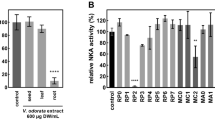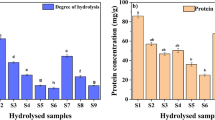Abstract
Curcumin, a polyphenol, an important constituent of turmeric is used as dietary spice and herbal remedy. In the present work, we aim to assess the effect of curcumin on some physiologically significant enzymes such as lysosomal cysteine proteases—Cathepsin B, Cathepsin H and Phosphatases—acid and alkaline phosphatases. Elevated levels of these enzymes have been reported in various diseased conditions. The in vitro enzyme inhibition studies emphasizes on the pharmacological basis of various therapeutic uses of turmeric. The enzymes were first purified using the techniques of acetone powder preparation, homogenisation, (NH4)2SO4 fractionation, molecular sieve chromatography and cation exchange chromatography. Thereafter, the inhibitory effect of curcumin was evaluated on Cathepsin B [3.4.22.1], Cathepsin H [3.4.22.16], acid phosphatase [3.4.3.2] and alkaline phosphatase [3.4.3.1] using well characterized substrates for particular enzymes. The study showed that curcumin effectively inhibited these enzymes. In addition, the results were correlated with the in silico docking studies.









Similar content being viewed by others
References
Azaryan A, Galoyan A (1987) Human and bovine brain cathepsin L and cathepsin H: purification, physico-chemical properties, and specificity. Neurochem Res 12:207–221
Bond JS, Butler PE (1987) Intracellular proteases. Annu Rev Biochem 56:333–364
Bradford MM (1976) A rapid and sensitive method for the quantitation of microgram quantities of protein utilizing the principle of protein-dye binding. Anal Biochem 72:248–254
Chen H, Zhang ZS, Zhang YL, Zhou DY (1999) Curcumin inhibits cell proliferation by interfering with the cell cycle and inducing apoptosis in colon carcinoma cells. Anticancer Res 19:3675–3680
Cornago P, Claramunt RM, Bouissane L, Alkorta I, Elguero J (2008) A study of the tautomerism of β-dicarbonyl compounds with special emphasis on curcuminoids. Tetrahedron 64:8089–8094
Ferrari E, Pignedoli F, Imbriano C, Marverti G, Basile V, Venturi E, Saladini M (2011) Newly synthesized curcumin derivatives: crosstalk between chemico-physical properties and biological activity. J Med Chem 54:8066–8077
Gabrijelcic D, Turk V et al (1992) Cathepsin B, H and L in human breast carcinoma. Eur J Clin Chem Clin Biochem 30:69–74
Guncar G, Podobrik M, Pungercar J, Strukelj B, Turk V, Turk D (1998) Crystal structure of porcine Cathepsin H determined at 2.1 Å resolution: location of the mini—chain C-terminal carboxyl group defines Cathepsin H amino peptidase function. Structure 6:51–61
Holtz KM, Stec B, Kantrowitz ER (1999) A model of transition state in the alkaline phosphatase reaction. J biol chem 74:8351
Huang MT, Lou YR, Ma W, Newmark HL, Reuhl KR, Conney AH (1994) Inhibitory effects of dietary curcumin on fore stomach, duodenal, and colon carcinogenesis in mice. Cancer Res 54:5841–5847
Huber CP, Campbell RL Hasnain S, Hirama T, To R (2003) Crystal structure of the tetragonal form of human liver Cathepsin B. http://www.ebi.ac.uc/pdbe-srv/view/entry/2ipp/citation.html
Kamboj RC, Pal S, Singh H (1990) Purification and characterization of cathepsin B from goat brain. J Biosci 15:397–408
Kelleher JA, Irvine D, Eveleth D, Viejo M (1996) U S Patent. 5:567–724
Knight CG (1980) Human cathepsin B. Application of the substrate N-benzyloxycarbonyl-l-arginyl-l-arginine 2-naphthylamide to a study of the inhibition by leupeptin. Biochem J 189:447–453
Lal J, Gupta SK, Thavaselvam D, Agarwal DD (2012) Design, synthesis, synergistic antimicrobial activity and cytotoxicity of 4-aryl substituted 3, 4-dihydropyrimidinones of curcumin. Bioorg Med Chem Lett 22:2872–2876
Lange PH, Millan JL, Stigbrand T, Vessella RL, Ruoslahti E, Fishman WH (1982) Placental alkaline phosphatase as a tumor marker for seminoma. Cancer Res 42:3244–3247
Menon VP, Sudheer AR (2007) Antioxidant and anti-inflammatory properties of curcumin. Adv Exp Med Biol 595:105–125
Mishra S, Palanivelu K (2008) The effect of curcumin (turmeric) on Alzheimer’s disease: an overview. Ann Indian Acad Neurol 11:13–19
Mukhopadhyay A, Bueso-Ramos C, Chatterjee D, Pantazis P, Aggarwal BB (2001) Curcumin down regulates cell survival mechanisms in human prostate cancer cell lines. Oncogene 20:7597–7609
Musil D, Zucic D, Turk D, Engh RA, Mayr I, Huber R, Popovicl T, Turk V, Towatari T, Katunuma N, Bode W (1991) The refined 2.15 A X-ray crystal structure of human liver cathepsin B: the structural basis for its specificity. EMBO J 10:2321–2330
Nogaki A, Satoh K, Iwasaka K, Takano H, Takahama M, Ida Y, Sakagami H (1998) Radical intensity and cytotoxic activity of curcumin and gallic acid. Anticancer Res 18:3487
Pal S, Choudhuri T, Chattopadhyay S, Bhattacharya A, Datta GK, Das T, Sa G (2001) Mechanisms of curcumin-induced apoptosis of Ehrlich’s ascites carcinoma cells. Biochem Biophys Res Commun 288:655–658
Raghav N, Kamboj RC, Parnami S, Singh H (1995) Physiochemical properties of brain Cathepsin H. Indian J Biochem Biophys 32:279–285
Raghav N, Singh M, Kaur R, Suman Priyanka (2010) Proteolytic studies in liver homogenate in presence of Phenyl hydrazones. Int J Pharm Technol 2:743–749
Rao CV (2007) Regulation of COX and LOX by curcumin. Adv Exp Med Biol 595:213–226
Sa G, Das T (2008) Anti cancer effects of curcumin: cycle of life and death. Cell Div 3:1–14
Sahney SK, Singh R (2001) Enzymes in introductory practical biochemistry, 1st edn. Norosa publication house, New Delhi, pp 135–137
Schweiger A, StabucB PopovicT, TurkV KosJ (1997) Enzyme-linked immunosorbent assay for the detection of total cathepsin H in human tissue cytosols and sera. J Immunol Methods 201:165–232
Sindhwani P, Hampton JA, Baig MM, Keck RW, Selman SH (2000) Curcumin: a food spice with cytotoxic activity against urinary bladder cancer. Surg Forum 51:625–626
Stoschek CM (1990) Quantitation of protein. Methods Enzymol 182:50–68
Tsushima H, Ueki A, Matsuoka Y, Mihara H, Hopsu-Havu VK (1991) Characterization of a cathepsin-H-like enzyme from a human melanoma cell line. Int J Cancer 48:726–732
Zhou H, Beevers CS, Huang S (2011) The targets of curcumin. Curr Drug Targets 12:332–347
Acknowledgments
Among the authors, Indu Ravish is thankful to University Grant Commission New Delhi, India for award of JRF and also to Kurukshetra University, Kurukshetra for providing necessary research laboratory facilities.
Conflict of interest
The authors have declared no conflict of interest.
Author information
Authors and Affiliations
Corresponding author
Rights and permissions
About this article
Cite this article
Ravish, I., Raghav, N. Curcumin as inhibitor of mammalian Cathepsin B, Cathepsin H, acid phosphatase and alkaline phosphatase: a correlation with pharmacological activities. Med Chem Res 23, 2847–2855 (2014). https://doi.org/10.1007/s00044-013-0872-1
Received:
Accepted:
Published:
Issue Date:
DOI: https://doi.org/10.1007/s00044-013-0872-1




